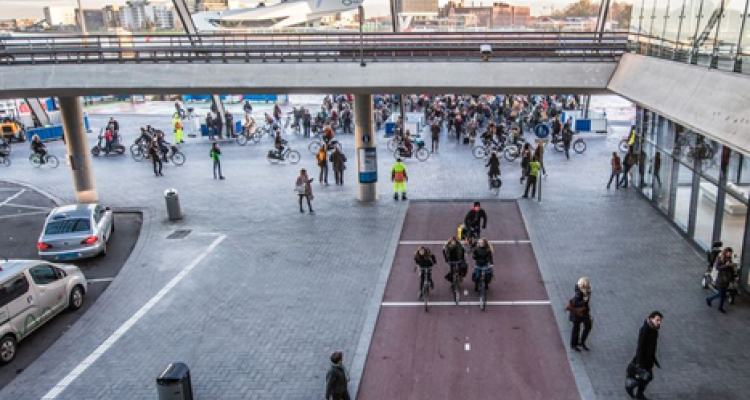
Student information
MSc thesis topic: Agent-based modeling and simulation of shared space in virtual reality
Agent-based modeling (ABM) is an advanced computational approach used to represent dynamic interactions between humans (aka “agents”) and the environment according to predefined rules. In shared space, all road users are encouraged to occupy the same space with little physical or visual separation. Complex interactions that occur among independent agents in such space create a system whose behavior is difficult to predict with traditional 2D modeling techniques. In this regard, virtual reality (VR) can create realistic simulations of real-world scenarios where users can experience and interact with objects in a 3D virtual environment using natural body and head movements. VR therefore has the potential to serve as an authentic and scalable testbed for simulating traffic events around a shared space, gathering individual behavioral reactions, and improving the performance of ABM at the micro level.
This project addresses modeling and simulating pedestrian behavior when interacting with other road users such as cyclists and private car drivers in shared spaces. Leveraging monitoring data collected from a shared space in Amsterdam, different types of interactions among pedestrians, vehicles, and bicycles will be identified and distilled into a set of social contact scenarios. A subset of scenarios will then be simulated in a VR replica of the shared space. Experiencing these ground-truth reference simulations, individuals will be assessed on behavioral measures such as eye movements and trajectories in response to different interaction conditions. The results will be compared with and integrated into an existing ABM of the shared space in Amsterdam to explore the potential and effectiveness of VR for ABM.
Immersive technologies such as augmented and virtual reality are entering a new era. Thanks to substantial investments by leading companies (e.g., Meta(™), Microsoft(™), and Google(™)) catapulting immersive media into the mainstream, devices have become affordable and seldom cause cybersickness anymore. At the same time, the creation and design of immersive experiences are getting easier and easier and more accessible to many more people. Tools such as Unity(™) or Unreal(™), that is, game engines, are sophisticated and well-supported development environments. Together with recent advances in sensing and tracking techniques, we are now in a position to efficiently create realistic 3D simulations of existing environments and use them in a wide variety of social and behavioral research.
Relevance to research/projects at GRS or other groups
GRS is leading efforts to develop visualization methods and tools for social good. The project will build upon existing datasets and models and is additionally supported by a university-wide research effort (WANDER) seeking to establish immersive technologies firmly in the portfolio of research and education tools for environmental and societal challenges.
Objectives (select one or a subset from below or bring your own ideas)
- Develop an immersive virtual environment to simulate pedestrian-bicycle-car interactions in a shared space under different density conditions.
- Create a methodological framework for the collection, analysis, and application of collected behavioral data in VR to ABM.
- Run a pilot study to examine the effect of traffic density or different interaction scenarios on pedestrians’ perception and behavior, to iteratively improve the simulation performance of pedestrian behavior, or to evaluate and calibrate the existing ABM for a shared space.
Literature
- Klügl, F., & Bazzan, A. L. C. (2012). Agent‐Based Modeling and Simulation. AI Magazine, 33(3), 29–40.
- Feng, Y., Xu, Z., Farah, H., & van Arem, B. (2023). Does another pedestrian matter? A Virtual Reality study on the interaction between multiple pedestrians and autonomous vehicles in shared space. Advance online publication.
- Argota Sánchez-Vaquerizo, J., Hausladen, C. I., Mahajan, S., Matter, M., Siebenmann, M., van Eggermond, M. A. B., & Helbing, D. (2024). A virtual reality experiment to study pedestrian perception of future street scenarios. Scientific Reports, 14(1), 4571.
- Warmerdam, M. (2021). Combining Agent-Based Models with Virtual Reality to collect micro-level behavioural data in a smoke evacuation situation. MSc Thesis, Utrecht University.
- Cheliotis, K. (2021). ABMU: An Agent-Based Modelling Framework for Unity3D. In SoftwareX (Vol. 15, p. 100771). Elsevier BV.
Requirements
- Interest in immersive technologies
- Interest in technical development or empirical evaluations
Theme(s): Modelling & visualisation, Human–space interaction